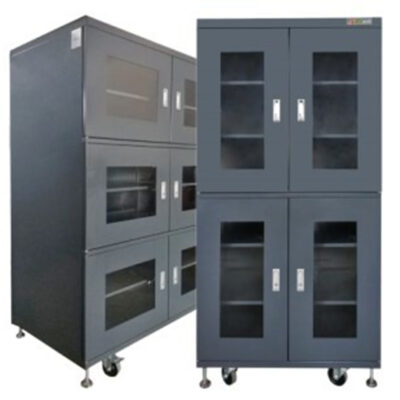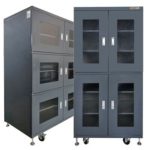In environments where humidity can damage sensitive equipment or materials, dry cabinets are the go-to solution. Whether you’re working in electronics, photography, pharmaceuticals, or research labs, keeping items free from moisture is essential. Dry cabinets offer a controlled, low-humidity storage space that protects valuable assets from corrosion, mold, oxidation, and other moisture-induced damage.
In this blog, we’ll explore what dry cabinets are, how they work, where they’re used, and how to choose the right one for your needs.
What is a Dry Cabinet?
A dry cabinet is an enclosed storage unit equipped with humidity control technology. It maintains a low-humidity environment (typically below 50% RH and sometimes as low as 1% RH) to preserve moisture-sensitive items.
Dry cabinets come in different types—manual desiccant-based, automatic electronic, and nitrogen-filled—each serving specific storage needs.
How Do Dry Cabinets Work?
Dry cabinets use dehumidifying methods such as:
-
Desiccant modules: Absorb moisture and regenerate automatically.
-
Thermoelectric cooling: Extracts moisture from air.
-
Nitrogen purging: Fills the cabinet with dry nitrogen to displace humidity.
Advanced models include digital hygrometers, auto-dehumidification cycles, and programmable humidity levels.
Applications of Dry Cabinets
1. Photography
Photographers store lenses, cameras, and film in dry cabinets to prevent fungal growth, which can damage optics permanently.
2. Electronics and Semiconductors
PCBs, ICs, and other sensitive components must be stored in a dry environment to avoid corrosion, oxidation, and malfunction.
3. Pharmaceuticals
Moisture-sensitive chemicals, tablets, and samples are protected in dry cabinets to maintain efficacy and shelf life.
4. Research Labs
Samples, lab tools, and chemicals that react to humidity are kept in controlled dry environments for accurate results.
5. Art & Antique Preservation
Paintings, manuscripts, and rare collectibles are safeguarded from moisture-induced deterioration.
Key Features to Look for in a Dry Cabinet
When selecting a dry cabinet, keep the following features in mind:
Humidity Control Range
Check for adjustable humidity levels depending on your storage requirement (10%, 20%, or 40% RH, etc.).
Digital Display
Digital displays allow precise monitoring of humidity and temperature levels.
Build Quality & Sealing
High-quality insulation and tight seals prevent air exchange with the outside environment.
Power Efficiency
Choose models that consume less electricity or use energy-saving dehumidifying cycles.
Storage Capacity
Dry cabinets are available in compact tabletop versions to large industrial models. Choose one as per your volume requirement.
Benefits of Using a Dry Cabinet
-
Prevents damage from moisture, mold, corrosion, or rust
-
Extends the life of expensive equipment and materials
-
Improves reliability in manufacturing, lab testing, and photography
-
Reduces rework/replacement costs
-
Clean and organized storage space
How to Choose the Right Dry Cabinet for Your Needs?
Ask yourself:
-
What items will I store?
-
How sensitive are they to humidity?
-
Do I need quick access or long-term storage?
-
What’s my budget and space availability?
If you’re a photographer, a 30–50L cabinet may be enough. For an electronics manufacturer, a 200L+ cabinet with auto dehumidification might be ideal.
Maintenance Tips for Dry Cabinets
-
Avoid frequent door opening – it disrupts humidity levels.
-
Wipe internal shelves regularly to prevent dust buildup.
-
Monitor digital indicators to ensure optimal RH level.
-
Calibrate sensors once in a while (if applicable).
-
Replace desiccants (if manual) when they lose effectiveness.
Environmental Consideration
Modern dry cabinets are eco-friendly—they reduce wastage due to spoilage and often consume less power. Many models are RoHS compliant, making them suitable for cleanroom and green manufacturing setups.
Dry Cabinets vs. Other Storage Options
| Feature | Dry Cabinets | Regular Cabinets | Vacuum Sealed Bags |
|---|---|---|---|
| Humidity Control | ✅ Yes | ❌ No | ⚠️ Limited |
| Digital Monitoring | ✅ Yes | ❌ No | ❌ No |
| Reusable/Accessible | ✅ Yes | ✅ Yes | ❌ No |
| Suitable for Long-Term | ✅ Yes | ❌ No | ⚠️ Maybe |
Conclusion
If your work involves storing high-value, moisture-sensitive items, investing in a dry cabinet is a smart move. With controlled humidity, reliable storage, and long-term protection, dry cabinets serve professionals across industries. Be it for electronics, photography, labs, or pharmaceuticals—there’s a dry cabinet tailored to your needs.










